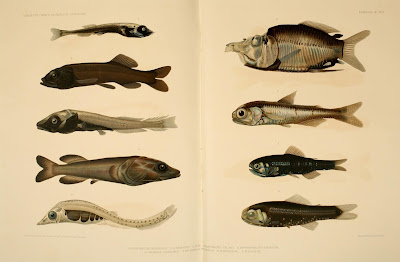Here's another wonderful forgotten artist that emerged from history along my research into the lives of pioneering printmaking German ladies. Although she was not involved in any woodblock printmaking to my knowledge she exhibited in Munich in 1904 with several well known woman printmakers.
And although there're hardly any surviving examples of her work accesable I managed to dig up some. Help me by sending more examples of her work or their whereabouts . But most intriguing is the short biography I put together from (translated) scraps, bits and pieces, genealogical research etc.. that I 've included in my index.
Among the few etchings is this great example of two traditional dressed Japanese women in a hair styling ritual. But in this years, in Germany, who other then Emil Orlik will have been responsible for the choice or inspiration of her subject. If I only knew how .....
Orlik no doubt was also a source of inspiration for Erich Wolfsfeld (1884-1957) who also taught in the same Institute as Orlik but I will tell you about him later. He never travelled to Japan but rose to great fame later because of his North Africa trips and related paintings and etchings. But now I'm wandering of my track.
Anyway: enjoy the following biography illustrated with some finds.
Popert,
Charlotte
(Hamburg 01-03-1848 – 01-03-1918 Rome)
Jewish painter and graphic
artist. Daughter of prosperous Hamburg leather merchant Joseph Meyer Popert
(1797-1868) and Emma Vidal Rothschild (1811-1866).
While living in Rome
she was much appraised by Ludwig Pollack, director of “Museo Barracco di
Scultura Antica” in Rome.
This Popert family (originating from the city
of Boppard near Koblenz) was living in Hamburg since the early 18th
century resulting in building and running a flourishing and well respected trade bank and
becoming very, very wealthy. In the early 19th century the sons of banker Meyer
Wolf Popert (1763-1812) were all successful in Hamburg trade and commerce
while the bank eventually went bankrupt. Joseph’s brother, Charlotte's uncle, Wolf Meyer Popert (1795-1846) was a famous chess-player playing
in London against the world’s finest players. Joseph, Charlotte’s father,
learned the tanning business probably in Scandinavia.
Charlotte’s niece Anna Brinckmann (1846
– after 1903) married sculptor Joseph (von) Kopf (1827-1903 Rome). Anna
Brinckmann’s mother Anna Theresa Popert was Charlotte’s father sister. Their daughter, Martha
Kopf (b. Rome 1870) married sculptor Hugo Berwald (1863-1937). He
was the brother of William Henry Berwald (1864-1948) the composer.
Salomon Heine (1767-1844). His
mother was Mathilde Martha Eva Popert (1739-1799), dr. of Meyer
Samson Popert and Fromet Hekscher). Although also from a banking and trading
family he came to Hamburg in 1784 pennyless and learned the banking business
inside the Hamburg Popert bank. He grew immensely rich, earning his knickname
“Rotschildt of Hamburg” and was a great philanthropist and patron to the arts
to the city of Hamburg. He happened to be the uncle of Germany’s foremost poet Heinrich
Heine (1797-1856), above, who was promoted by his uncle and by Joseph Meyer Popert,
Charlotte’s father, who was also but more distantly related to the Great Poet.
Ludwig Pollak (Prague 14 September 1868, Prague – 1943 Auschwitz) was an Austro-Czech classical archaeologist,
antiquities dealer, and director of the Museo Barracco di Scultura Antica in Rome.
He is perhaps best known for discovering in 1906 the missing right arm of
Laocoön in the famous ancient Roman sculpture Laocoön and his sons.
She studied in Weimar “Fürsterliche freien Zeichenschule” with painter
etcher Friedrich Preller (the elder) (1804-1878). Then she studied in
Düsseldorf, Paris and visiting Rome in 1778 meeting and falling in love with
Ligurian painter Nicolò Barabino (1832-1891) with whom she travelled to
London. After his death she settled in Rome in the 1890’s where she met and became
close friends with John Singer Sargent (1856-1925) of whom she owned
several painting and painter Pio Joris (1843-1922).
Wealthy by birth she had build a tasteful villa
at the “Lungotevere Arnolda da Brescia” what became a meeting place for
artists. She travelled twice to Sardinia (1899 – 1900) and to the Isle of Capri
(1896) staying at the villa of German painter Christian Wilhelm Allers
(1857-1915).
She was a meacenas to the arts and a philantrope to the sick and
the poor and visited Queen consort Margaretha of Savoye (1851- 1926) who
had been interested in a series (port folio) of etchings made after a trip to Sardinia. She
created the etched portraits of both King Umberto-I of Savoye (1844-1900) and
his wife. During WW1 she was forced to leave Italy (1915), her house,
collections and work were seized and confiscated.
She wrote an eye-whitness
account (privatly published 1915 in Hamburg) of the misery of the war rufugees
in East-Prussia. After the war ended she returned to Italy in 1918 staying in
the studio of Pio Joris. It is said she died of a broken heart soon
after in 1918. Part of her collections were assimilated in the collections of
the National Opera in Rome.
Not known by woodblock prints but she is
represented with 4 etching (among which are portraits of “Fürst Bismarck”, “Crispi” and “professor
Joseph von Kopf” ) + the Sardinia port folio containing 10 etchings and a
program with some 60 female and 85 male graphic artists in the important 1904 “Catalog of etchings, engravings and lithographs (chiefly German but
including work by Austrian, Swiss, Dutch and English artists)” by Reinhard Piper, Munich
--------------------------
All pictures borrowed freely from the internet for friendly, educational and non commercial use only.




































